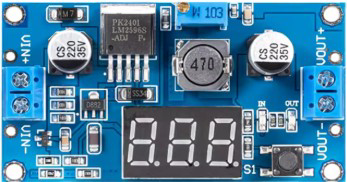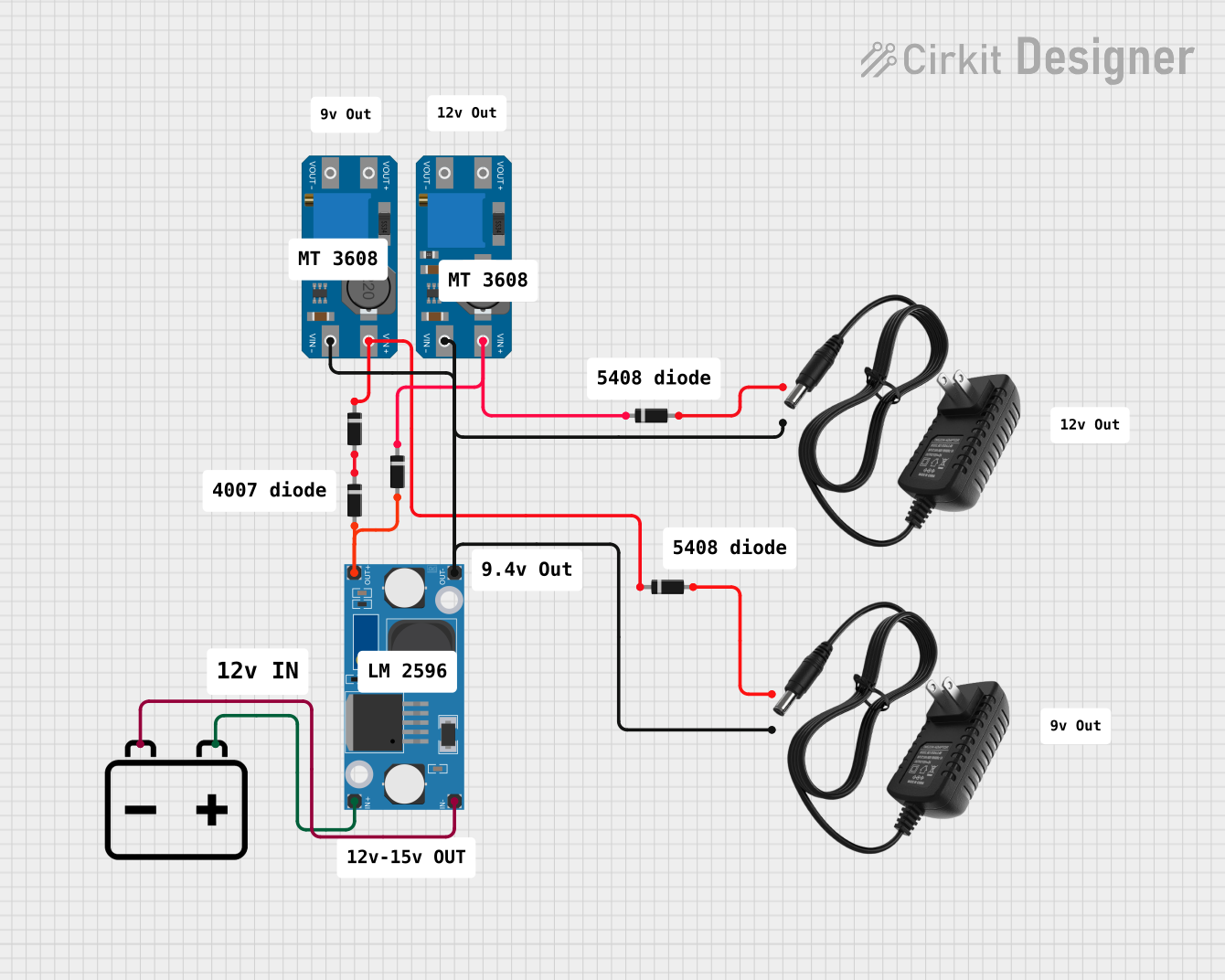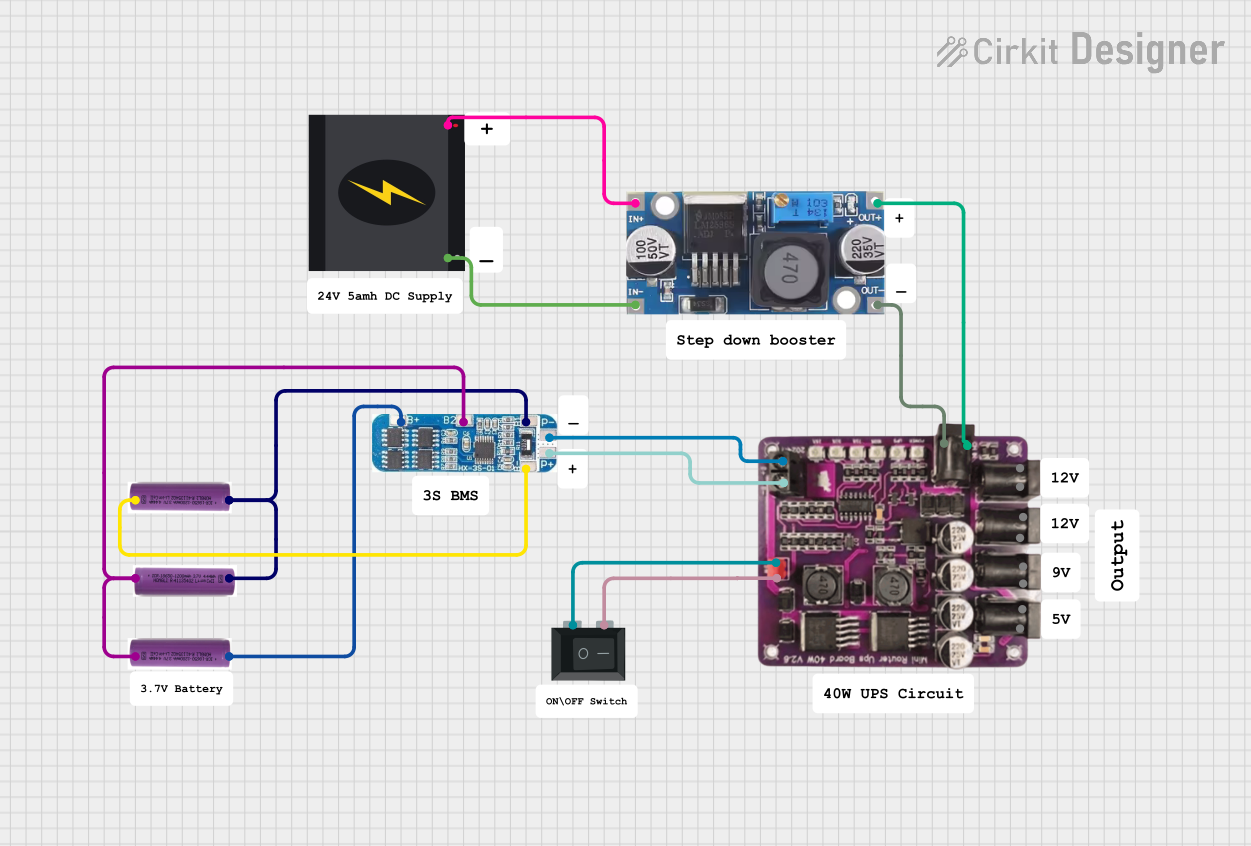
How to Use LM25965 DC-DC Step Down Power Supply: Examples, Pinouts, and Specs

 Design with LM25965 DC-DC Step Down Power Supply in Cirkit Designer
Design with LM25965 DC-DC Step Down Power Supply in Cirkit DesignerIntroduction
The LM25965 is a high-efficiency DC-DC buck converter designed to step down voltage from a higher input level to a stable, lower output voltage. This component is widely used in power supply circuits for its ability to deliver high current with excellent efficiency, making it ideal for powering microcontrollers, sensors, and other electronic devices. Its compact design and integrated features simplify circuit design and reduce the need for external components.
Explore Projects Built with LM25965 DC-DC Step Down Power Supply

 Open Project in Cirkit Designer
Open Project in Cirkit Designer
 Open Project in Cirkit Designer
Open Project in Cirkit Designer
 Open Project in Cirkit Designer
Open Project in Cirkit Designer
 Open Project in Cirkit Designer
Open Project in Cirkit DesignerExplore Projects Built with LM25965 DC-DC Step Down Power Supply

 Open Project in Cirkit Designer
Open Project in Cirkit Designer
 Open Project in Cirkit Designer
Open Project in Cirkit Designer
 Open Project in Cirkit Designer
Open Project in Cirkit Designer
 Open Project in Cirkit Designer
Open Project in Cirkit DesignerCommon Applications
- Powering microcontrollers and digital circuits
- Battery-powered devices
- Industrial automation systems
- LED drivers
- Consumer electronics
Technical Specifications
The LM25965 is designed to handle a wide range of input voltages and provide a stable output. Below are its key technical specifications:
| Parameter | Value |
|---|---|
| Input Voltage Range | 4.5V to 40V |
| Output Voltage Range | Adjustable (1.2V to 37V) |
| Output Current | Up to 5A |
| Efficiency | Up to 90% |
| Switching Frequency | 150 kHz |
| Operating Temperature | -40°C to +125°C |
| Package Type | TO-220 or TO-263 |
Pin Configuration and Descriptions
The LM25965 typically comes in a 5-pin TO-220 or TO-263 package. Below is the pinout description:
| Pin Number | Pin Name | Description |
|---|---|---|
| 1 | VIN | Input voltage pin. Connect to the positive terminal of the input power source. |
| 2 | GND | Ground pin. Connect to the negative terminal of the input power source. |
| 3 | VOUT | Output voltage pin. Provides the regulated output voltage. |
| 4 | FB | Feedback pin. Used to set the output voltage via an external resistor divider. |
| 5 | ON/OFF | Enable pin. Used to turn the regulator on or off. |
Usage Instructions
How to Use the LM25965 in a Circuit
- Input Voltage: Ensure the input voltage is within the range of 4.5V to 40V.
- Output Voltage Adjustment: Use a resistor divider network connected to the FB pin to set the desired output voltage. The output voltage can be calculated using the formula: [ V_{OUT} = V_{REF} \times \left(1 + \frac{R1}{R2}\right) ] where ( V_{REF} ) is typically 1.2V.
- Capacitors: Place input and output capacitors close to the VIN and VOUT pins to stabilize the circuit and reduce noise. Recommended values are:
- Input capacitor: 100 µF electrolytic
- Output capacitor: 220 µF electrolytic
- Inductor Selection: Choose an inductor with a current rating higher than the maximum output current and an appropriate inductance value to ensure stable operation.
- Enable Pin: Connect the ON/OFF pin to ground to enable the regulator. Leave it floating or apply a high signal to disable it.
Example Circuit
Below is a basic circuit diagram for using the LM25965 to step down 12V to 5V:
VIN (12V) ----+----[CIN]----+----[LM25965]----+----[COUT]---- VOUT (5V)
| | | |
GND FB GND GND
Arduino UNO Example Code
The LM25965 can be used to power an Arduino UNO. Below is an example code to read a sensor powered by the LM25965:
// Example code to read an analog sensor powered by the LM25965
// Ensure the LM25965 is providing a stable 5V output to the Arduino UNO
const int sensorPin = A0; // Analog pin connected to the sensor
int sensorValue = 0; // Variable to store the sensor reading
void setup() {
Serial.begin(9600); // Initialize serial communication at 9600 baud
}
void loop() {
sensorValue = analogRead(sensorPin); // Read the sensor value
Serial.print("Sensor Value: ");
Serial.println(sensorValue); // Print the sensor value to the Serial Monitor
delay(1000); // Wait for 1 second before the next reading
}
Important Considerations
- Thermal Management: The LM25965 can generate heat during operation. Use a heatsink or ensure proper ventilation to prevent overheating.
- PCB Layout: Minimize the length of high-current paths and place decoupling capacitors as close as possible to the pins.
- Protection: Add a fuse or TVS diode at the input to protect against overcurrent or voltage spikes.
Troubleshooting and FAQs
Common Issues and Solutions
No Output Voltage
- Check the input voltage and ensure it is within the specified range.
- Verify that the ON/OFF pin is properly connected to enable the regulator.
- Inspect the feedback resistor network for correct values and connections.
Output Voltage is Unstable
- Ensure the input and output capacitors have the correct values and are placed close to the pins.
- Check the inductor value and ensure it meets the design requirements.
- Verify that the load current does not exceed the maximum rating.
Overheating
- Use a heatsink or improve airflow around the component.
- Reduce the load current if it exceeds the thermal limits of the device.
High Noise or Ripple
- Use low-ESR capacitors for input and output filtering.
- Ensure proper grounding and minimize the loop area in the PCB layout.
FAQs
Q: Can the LM25965 be used with a battery as the input source?
A: Yes, the LM25965 can be used with a battery as long as the input voltage is within the specified range (4.5V to 40V).
Q: How do I calculate the inductor value for my application?
A: The inductor value depends on the input voltage, output voltage, switching frequency, and load current. Use the formula provided in the datasheet or an online inductor calculator for accurate results.
Q: Is the LM25965 suitable for powering sensitive analog circuits?
A: Yes, but ensure proper filtering and decoupling to minimize noise and ripple.
Q: Can I use the LM25965 to step down 24V to 3.3V?
A: Yes, the LM25965 supports a wide output voltage range (1.2V to 37V). Ensure proper resistor values for the feedback network and adequate thermal management.